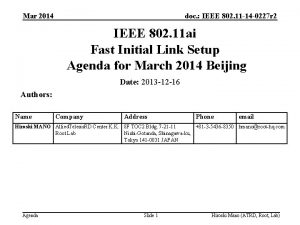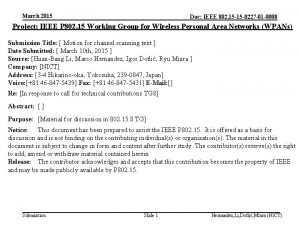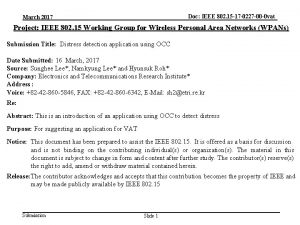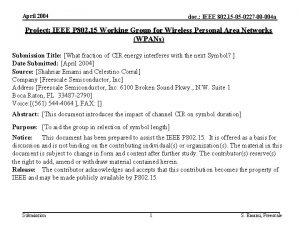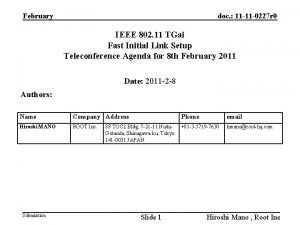Doc IEEE 802 15 17 0227 00 0






- Slides: 6

Doc: IEEE 802. 15 -17 -0227 -00 -0 vat November 2017 Project: IEEE 802. 15 Working Group for Wireless Personal Area Networks (WPANs) Submission Title: Driver-to-Drive Messaging Application using OWC Date Submitted: 08 November, 2017 Source: Sunghee Lee*, Namkyung Lee* and Sanghoon Lee* Company: Electronics and Telecommunications Research Institute* Address : Voice: +82 -42 -860 -5846, FAX: +82 -42 -860 -6342, E-Mail: sh 2@etri. re. kr Re: Abstract: This document introduces a Driver-to-Driver Messaging Application using OWC for Vehicular Assistant Technology (VAT). Purpose: To provided a concept models of Driver-to-Driver Messaging Application using OWC for Vehicular Assistant Technology (VAT) Interest Group Notice: This document has been prepared to assist the IEEE 802. 15. It is offered as a basis for discussion and is not binding on the contributing individual(s) or organization(s). The material in this document is subject to change in form and content after further study. The contributor(s) reserve(s) the right to add, amend or withdraw material contained herein. Release: The contributor acknowledges and accepts that this contribution becomes the property of IEEE and may be made publicly available by IEEE 802. 15 Submission Slide 1

Doc: IEEE 802. 15 -17 -0227 -00 -0 vat November 2017 Contents • Basic concept • Traditional ways for communication between drivers • Use cases for OWC based Messaging Application • Conclusion Submission Slide 2 Sunghee Lee, ETRI

Doc: IEEE 802. 15 -17 -0227 -00 -0 vat November 2017 Basic Concept • Exchange messages between a driver of the front vehicle and the back vehicle by using OWC technology • A driver’s speech is delivered based on OWC to target drivers • Target driver can read or hear the message • Transmitter(TX) and receiver(RX) – The front vehicle • • RX : rear camera / side camera TX : rear light / blinker / window signage – The back car • • Submission RX : front camera TX : front light / blinker / window signage Slide 3

Doc: IEEE 802. 15 -17 -0227 -00 -0 vat November 2017 Traditional ways for communication between drivers • Traditional ways to communicate between drivers – Horn honking/flashing lights : warn danger or express complaint to other drivers – Sign language : inform status of vehicle or warn danger – Emergency light : inform abnormal status, show appreciation or apology • Disadvantages of traditional ways – – – Submission Unclear Makes other drivers uncomfortable Unnecessary broadcast Sign language is not familiar to some drivers Drivers may lose attention on driving for a while Slide 4

Doc: IEEE 802. 15 -17 -0227 -00 -0 vat November 2017 Use cases for OWC based Messaging Application • Communication between drivers – – Drivers can ask clearly what they want to the target driver Can prevent annoying honking sound or flashing light Drivers can maintain attention on driving while communicating with other drivers Drivers can have small talk • Give detail information about abnormal status of an adjacent vehicle – Instead of honking horn or flashing light, specifically describe status of the vehicle – E. g. flat tire, which tire is punctured, smoke from the car etc. • Notify my situation to other drivers – Instead of turning on emergency light, specifically explain status of my problem – E. g. health problem, emergency situation, detail information about car trouble Submission Slide 5

Doc: IEEE 802. 15 -17 -0227 -00 -0 vat November 2017 Conclusion • Traditional communication ways between drivers are unclear, noisy and danger • By using OWC driver can communicate directly • Driver-to-driver messaging application using OWC can deliver clear message without noise and losing attention on driving Submission Slide 6 Sunghee Lee, ETRI







